Sustainability Transitions in University Food Service—A Living Lab Approach of Locavore Meal Planning and Procurement
Abstract
1. Introduction
- to develop a coherent set of sustainability criteria or conceptual standards regarding procurement and meal planning;
- to develop actual meals for a weekly menu;
- to evaluate the potential of organic “locavore” menu planning and procurement against the goals of budget-neutrality and the PD recommendations.
2. Methods and Approach
2.1. First Feedback Cycle: Stakeholder Engagement
2.2. First Feedback Cycle: Defining the Issue, Planning the Action
2.3. Development of a Conceptual Standard for Sustainable Meal Planning and Procurement
2.4. First Feedback Cycle: Taking Action
2.5. First Feedback Cycle: Analysis and Reflection
2.6. Second Feedback Cycle: Redefining the Action
2.7. Second Feedback Cycle: Revised Action
2.8. Second Feedback Cycle: Analysis and Reflection of Revised Action
3. Results
3.1. First Cycle Results: Mini Survey
3.2. First Cycle Results—Best Practice Case Studies
3.3. First Cycle Results—Preliminary Criteria
3.4. First Cycle Results—Recipe Description
3.5. First Cycle Results—Feedback from Kassel ASAS
3.6. First Cycle Results—Evaluation of Meals According to the Preliminary Conceptual Standard
3.7. Second Cycle Results—Additional Best Practice Presentations
3.8. Second Cycle Results—Final Set of Criteria/Conceptual Standard
3.9. Second Cycle Results—Improvements in Refined Meals and Final Feedback by ASAS
3.10. Second Cycle Results—Evaluation of Meals According to the Final Conceptual Standard
3.10.1. Criteria 1: 100% Locally Sourced from North Hesse
3.10.2. Criteria 2: 100% Certified Organic Ingredients
3.10.3. Criteria 3: Dietary Recommendations Based on the PD and the DGE Standards
3.10.4. Criteria 4: Lightly Processed Foods with Maximum Convenience Level Three
3.10.5. Criteria 5: Budget Neutrality—Cost of Goods per Meal Not to Exceed EUR 1.60
3.10.6. Criteria 6: Life Cycle Assessment
4. Discussion
Author Contributions
Funding
Institutional Review Board Statement
Informed Consent Statement
Data Availability Statement
Acknowledgments
Conflicts of Interest
References
- Neto, B.; Gama Caldas, M. The use of green criteria in the public procurement of food products and catering services: A review of EU schemes. Environ. Dev. Sustain. 2018, 20, 1905–1933. [Google Scholar] [CrossRef]
- Rückert-John, J.; John, R.; Niessen, J. Nachhaltige Ernährung außer Haus-der Essalltag von Morgen. In Die Zukunft auf Dem Tisch: Analysen, Trends und Perspektiven der Ernährung von Morgen; Ploeger, A., Hirschfelder, G., Schönberger, G., Eds.; VS Verlag für Sozialwissenschaften: Wiesbaden, Germany, 2011; pp. 41–55. ISBN 978-3-531-93268-2. [Google Scholar]
- Pfeiffer, C.; Speck, M.; Strassner, C. What Leads to Lunch—How Social Practices Impact (Non-) Sustainable Food Consumption/Eating Habits. Sustainability 2017, 9, 1437. [Google Scholar] [CrossRef]
- Statista. Umsatz im Außer-Haus-Markt in Deutschland 2019. Available online: https://de.statista.com/statistik/daten/studie/209505/umfrage/konsumentenausgaben-fuer-lebensmittel-ausser-haus/ (accessed on 22 March 2021).
- European Comission. Public Procurement Indicators 2017: DG GROW, G-Single Market for Public AdministrationG4-Innovative and eProcurement. Available online: https://ec.europa.eu/docsroom/documents/38003 (accessed on 25 February 2020).
- Schreiber, K.; Hickey, G.M.; Metson, G.S.; Robinson, B.E.; MacDonald, G.K. Quantifying the foodshed: A systematic review of urban food flow and local food self-sufficiency research. Environ. Res. Lett. 2021, 16, 23003. [Google Scholar] [CrossRef]
- Engelmann, T.; Speck, M.; Rohn, H.; Bienge, K.; Langen, N.; Howell, E.; Göbel, C.; Friedrich, S.; Teitscheid, P.; Bowry, J.; et al. Sustainability Assessment of Out-of-Home Meals: Potentials and Challenges of Applying the Indicator sets NAHGAST Meal-Basic and NAHGAST Meal-Pro. Sustainability 2018, 10, 562. [Google Scholar] [CrossRef]
- Andreas, A.; Verena, B.; Antonia, B.; Bonke, P.F. Nachhaltig Außer Haus Essen: Von der Idee Bis Auf Den Teller; Teitscheid, P., Langen, N., Speck, M., Rohn, H., Eds.; ISS-oekom: München, Germany, 2018; ISBN 978-3-96238-063-2. [Google Scholar]
- Sanchez-Flores, R.; Sotelo, S.C.; Ojeda-Benitez, S.; Navarro-Gonzalez, C.R. Sustainable Procurement to Enhance Organizational Performance in Supply Chain Management: Current Research and Practices. In Handbook of Research on Industrial Applications for Improved Supply Chain Performance; García-Alcaraz, J.L., Jamil, G.L., Avelar-Sosa, L., Eds.; IG Global Business Science Reference: Hershey, PA, USA, 2020; pp. 1–26. ISBN 9781799802020. [Google Scholar]
- Risku-Norja, H.; Løes, A. Organic food in food policy and in public catering: Lessons learned from Finland. Org. Agr. 2016, 7, 111–124. [Google Scholar] [CrossRef]
- Haack, M.; von Münchhausen, S.; Häring, A.M. Discrepancy between theory and practice: Procurement of local and organic food in public catering systems. In Social and Technological Transformation of Farming Systems: Diverging and Converging Pathways; Semantic Scholar: Seattle, WA, USA, 2016. [Google Scholar]
- Alsaffar, A.A. Sustainable diets: The interaction between food industry, nutrition, health and the environment. Food Sci. Technol. Int. 2016, 22, 102–111. [Google Scholar] [CrossRef]
- Saxe, H. The New Nordic Diet is an effective tool in environmental protection: It reduces the associated socioeconomic cost of diets. Am. J. Clin. Nutr. 2014, 99, 1117–1125. [Google Scholar] [CrossRef]
- Kneafsey, M.; Venn, L.; Schmutz, U.; Balázs, B.; Trenchard, L.; Eyden-Wood, P.; Bos, E.; Sutton, G.; Blackett, M. Short food supply chains and local food systems in the EU: A state of play of their socio-economic characteristics. JRC Sci. Policy Rep. 2013, 123, 129. [Google Scholar] [CrossRef]
- Rose, N.; Serrano, E.; Hosig, K.; Haas, C.; Reaves, D.; Nickols-Richardson, S.M. The 100-Mile Diet: A Community Approach to Promote Sustainable Food Systems Impacts Dietary Quality. J. Hunger Environ. Nutr. 2008, 3, 270–285. [Google Scholar] [CrossRef]
- Willett, W.; Rockström, J.; Loken, B.; Springmann, M.; Lang, T.; Vermeulen, S.; Garnett, T.; Tilman, D.; DeClerck, F.; Wood, A.; et al. Food in the Anthropocene: The EAT–Lancet Commission on healthy diets from sustainable food systems. Lancet 2019, 393, 447–492. [Google Scholar] [CrossRef]
- Goulding, T.; Lindberg, R.; Russell, C.G. The affordability of a healthy and sustainable diet: An Australian case study. Nutr. J. 2020, 19, 109. [Google Scholar] [CrossRef]
- Lopez, V.; Teufel, J.; Gensch, C.-O. How a Transformation towards Sustainable Community Catering Can Succeed. Sustainability 2020, 12, 101. [Google Scholar] [CrossRef]
- Peters, C.J.; Bills, N.L.; Wilkins, J.L.; Fick, G.W. Foodshed analysis and its relevance to sustainability. Renew. Agric. Food Syst. 2009, 24, 1–7. [Google Scholar] [CrossRef]
- Von Koerber, K.; Cartsburg, M. Zusatzkapitel: Potenziale der „Grundsätze für eine Nachhaltige Ernährung“ zur Unterstützung der SDGs. In Ökologische Landwirtschaft und die UN-Ziele für Nachhaltige Entwicklung—Bio Ist Teil der Lösung; Nature & More: Tokyo, Japan, 2020; pp. 50–100. [Google Scholar]
- Lacour, C.; Seconda, L.; Allès, B.; Hercberg, S.; Langevin, B.; Pointereau, P.; Lairon, D.; Baudry, J.; Kesse-Guyot, E. Environmental Impacts of Plant-Based Diets: How Does Organic Food Consumption Contribute to Environmental Sustainability? Front. Nutr. 2018, 5, 8. [Google Scholar] [CrossRef]
- Hawkes, C.; Fanzo, J. Nourishing the SDGs: Global Nutrition Report 2017, Bristol. 2017. Available online: https://openaccess.city.ac.uk/id/eprint/19322/ (accessed on 16 April 2021).
- Strassner, C.; Cavoski, I.; Di Cagno, R.; Kahl, J.; Kesse-Guyot, E.; Lairon, D.; Lampkin, N.; Løes, A.; Matt, D.; Niggli, U.; et al. How the Organic Food System Supports Sustainable Diets and Translates These into Practice. Front. Nutr. 2015, 2, 19. [Google Scholar] [CrossRef]
- Brunori, G.; Galli, F.; Barjolle, D.; van Broekhuizen, R.; Colombo, L.; Giampietro, M.; Kirwan, J.; Lang, T.; Mathijs, E.; Maye, D.; et al. Are Local Food Chains More Sustainable than Global Food Chains? Considerations for Assessment. Sustainability 2016, 8, 449. [Google Scholar] [CrossRef]
- Doherty, S.; Cawood, J.; Dooris, M. Applying the whole-system settings approach to food within universities. Perspect. Public Health 2011, 131, 217–224. [Google Scholar] [CrossRef]
- Grech, A.; Howse, E.; Boylan, S. A scoping review of policies promoting and supporting sustainable food systems in the university setting. Nutr. J. 2020, 19, 97. [Google Scholar] [CrossRef] [PubMed]
- Newton, J.; Dooris, M.; Wills, J. Healthy universities: An example of a whole-system health-promoting setting. Glob. Health Promot. 2016, 23, 57–65. [Google Scholar] [CrossRef] [PubMed]
- Chambers, D. Assessing and planning for environmental sustainability—A framework for institutions of higher education. In Sustainability at Universities: Opportunities, Challenge and Trends; Filho, W.L., Ed.; Peter Lang: Frankfurt am Main, Germany, 2009; pp. 287–296. ISBN 978-3-631-59690-6. [Google Scholar]
- Omrcen, E.; Lundgren, U.; Dalbro, M. Universities as role models for sustainability: A case study on implementation of University of Gothenburg climate strategy, results and experiences from 2011 to 2015. IJISD 2018, 12, 156. [Google Scholar] [CrossRef]
- Ringling, K.M.; Marquart, L.F. Intersection of Diet, Health, and Environment: Land Grant Universities’ Role in Creating Platforms for Sustainable Food Systems. Front. Sustain. Food Syst. 2020, 4, 70. [Google Scholar] [CrossRef]
- Teitscheid, P.; Göbel, C.; Weber, J. Beschreibung des AHG-Marktes in Deutschland und Europa. In Nachhaltig Außer Haus Essen: Von der Idee Bis Auf Den Teller; Teitscheid, P., Langen, N., Speck, M., Rohn, H., Eds.; ISS-oekom: München, Germany, 2018; pp. 27–38. ISBN 978-3-96238-063-2. [Google Scholar]
- Teufel, J.; Gensch, C. Weniger Fleisch in der Gemeinschaftsverpflegung—Herausforderungen für die Betriebe und erfolgreiche Lösungsansätze. In Nachhaltig Außer Haus Essen: Von der Idee Bis auf den Teller; Teitscheid, P., Langen, N., Speck, M., Rohn, H., Eds.; ISS-oekom: München, Germany, 2018; pp. 97–111. ISBN 978-3-96238-063-2. [Google Scholar]
- DGE. DGE-Qualitätsstandard für die Verpflegung in Betrieben. Available online: https://www.dge.de/gv/dge-qualitaetsstandards/?L=0 (accessed on 20 February 2021).
- Braun, C.; Rombach, M.; Häring, A.; Bitsch, V. A Local Gap in Sustainable Food Procurement: Organic Vegetables in Berlin’s School Meals. Sustainability 2018, 10, 4245. [Google Scholar] [CrossRef]
- Bundesanstalt Landwirtschaft und Ernährung. Gesunde Ernährung, sichere Produkte. Bericht der Bundesregierung zur Ernährungspolitik, Lebensmittel-und Produktsicherheit. Available online: https://www.bmel.de/SharedDocs/Downloads/DE/Broschueren/gesunde-ernaherung-sichere-produkte-bericht.html (accessed on 22 March 2021).
- Steinmeyer, F. Nachhaltiges Speisenangebot in der Außer-Haus-Gastronomie—Bestehende Hemmnisse und mögliche Pfadabhängigkeiten. In Nachhaltig Außer Haus Essen: Von der Idee Bis auf Den Teller; Teitscheid, P., Langen, N., Speck, M., Rohn, H., Eds.; ISS-oekom: München, Germany, 2018; pp. 39–49. ISBN 978-3-96238-063-2. [Google Scholar]
- Studierendenwerk Kassel. Ziel und Leistungsvereinbarung Zwischen dem Studierendenwerk und der Universität Kasse; Studierendenwerk Kassel: Kassel, Germany, 2014. [Google Scholar]
- Studierendenwerk Kassel. Medien-Studierendenwerk Kassel-Service rund ums Studium. Available online: https://www.studierendenwerk-kassel.de/de/wirueberuns/medien/#c1412 (accessed on 15 January 2021).
- Straube, F.; Figiel, A.; Ryll, N. Nachhaltige Just-in-Time Konzepte in der Beschaffungslogistik. In Jahrbuch Logistik 2015; Hanne Wolf-Kluthausen: Korschenbroich, Germany, 2015; p. 55. ISBN 978-3-9816403-1-1. [Google Scholar]
- Dillemuth, A.; Hodgson, K. Local, Healthy Food Procurement: Driving demand for and improving the availability of local and healthy foods. Grow. Food Connect. 2015, 1, 1–5. [Google Scholar]
- Barham, J.; Tropp, D.; Enterline, K.; Farbman, J.; Fisk, J.; Kiraly, S. Regional Food Hub Resource Guide; U.S. Department of Agriculture, Agricultural Marketing Service: Washington, DC, USA, 2012.
- Lindsey, T.; Slama, J. Building Successful Food Hubs: A Business Planning Guide for Aggregating and Processing Local Food in Illinois, Illinois. 2012. Available online: https://www.newventureadvisors.net/wp-content/uploads/2016/01/Building-Successful-Food-Hubs.pdf (accessed on 24 May 2021).
- European Commission. Farm to Fork Strategy—For a Fair, Healthy and Environmentally-Friendly Food System—Food Safety—European Commission. Available online: https://ec.europa.eu/food/farm2fork_en (accessed on 18 March 2021).
- Schebesta, H.; Candel, J.J.L. Game-changing potential of the EU’s Farm to Fork Strategy. Nat. Food 2020, 1, 586–588. [Google Scholar] [CrossRef]
- Haines, A.; Scheelbeek, P. European Green Deal: A major opportunity for health improvement. Lancet 2020, 395, 1327–1329. [Google Scholar] [CrossRef]
- EPHA. Public Procurement for Sustainable Food Environments: How Can the EU Farm to Fork Strategy Contribute? EPHA: Brussels, Belgium, 2019. [Google Scholar]
- Soldi, R. Sustainable Public Procurement of Food; CoR: Brussels, Belgium, 2018; ISBN 978-92-895-0957-2. [Google Scholar]
- Birt, C.; Buzeti, T.; Grosso, G.; Justesen, L.; Sarlio-Lähteenkorva, S. Healthy and Sustainable Diets for European Countries. Report of a Working Group; EUPHA: Utrecht, The Netherlands, 2017. [Google Scholar]
- Krivašonoka, I. Regulations of public food procurement: Opportunities and challenges. In Research for Rural Development; Latvia University of Agriculture: Jelgava, Latvia, 2017. [Google Scholar]
- Ruini, L.F.; Ciati, R.; Pratesi, C.A.; Marino, M.; Principato, L.; Vannuzzi, E. Working toward Healthy and Sustainable Diets: The “Double Pyramid Model” Developed by the Barilla Center for Food and Nutrition to Raise Awareness about the Environmental and Nutritional Impact of Foods. Front. Nutr. 2015, 2, 9. [Google Scholar] [CrossRef] [PubMed]
- Cope, S. Local Food Procurement/Locavorism. In Encyclopedia of Food and Agricultural Ethics; Thompson, P.B., Kaplan, D.M., Eds.; Springer Netherlands: Dordrecht, The Netherlands, 2013; pp. 1–8. ISBN 978-94-007-6167-4. [Google Scholar]
- Luttikholt, L. Principles of organic agriculture as formulated by the International Federation of Organic Agriculture Movements. NJAS—Wagening. J. Life Sci. 2007, 54, 347–360. [Google Scholar] [CrossRef]
- Burlingame, B.; Dernini, S. Sustainable Diets and Biodiversity: Directions and Solutions for Policy Research and Action: Proceedings of the International Scientific Symposium Biodiversity and Sustainable Diets United Against Hunger; FAO: Rome, Italy, 2012; ISBN 978-92-5-107288-2. [Google Scholar]
- Kretschmer, S.; Langfeldt, B.; Herzig, C.; Krikser, T. The Organic Mindset: Insights from a Mixed Methods Grounded Theory (MM-GT) Study into Organic Food Systems. Sustainability 2021, 13, 4724. [Google Scholar] [CrossRef]
- Markard, J.; Raven, R.; Truffer, B. Sustainability transitions: An emerging field of research and its prospects. Res. Policy 2012, 41, 955–967. [Google Scholar] [CrossRef]
- El Bilali, H. Research on agro-food sustainability transitions: Where are food security and nutrition? Food Sec. 2019, 11, 559–577. [Google Scholar] [CrossRef]
- Loeber, A.; Spaargaren, G.; Oosterveer, P. Food Practices in Transition: Changing Food Consumption, Retail and Production in the Age of Reflexive Modernity; Routledge: New York, NY, USA, 2012; ISBN 9780415880848. [Google Scholar]
- Westerlund, M.; Leminen, S. Managing the Challenges of Becoming an Open Innovation Company: Experiences from Living Labs. Technol. Innov. Manag. Rev. 2011, 1, 19–25. [Google Scholar] [CrossRef]
- Bergvall-Kåreborn, B.; Eriksson, C.I.; Ståhlbröst, A.; Svensson, J. A milieu for innovation: Defining living labs. In Proceedings of the ISPIM Innovation Symposium, New York, NY, USA, 6–9 December 2009. [Google Scholar]
- European Parliament. Regulation (EC) No 1221/2009 of the European Parliament and of the Council of 25 November 2009 on the Voluntary Participation by Organisations in a Community Eco-Management and Audit Scheme (EMAS), Repealing Regulation (EC) No 761/2001 and Commission Decisions 2001/681/EC and 2006/193/EC; European Parliament: Brussels, Belgium, 2009. [Google Scholar]
- Tourais, P.; Videira, N. Why, How and What do Organizations Achieve with the Implementation of Environmental Management Systems?—Lessons from a Comprehensive Review on the Eco-Management and Audit Scheme. Sustainability 2016, 8, 283. [Google Scholar] [CrossRef]
- Studierenden WERK BERLIN. Eco-Management and Audit Scheme (EMAS). Available online: https://www.stw.berlin/en/dining-facilities/themen/emas.html (accessed on 4 September 2020).
- Trott, C.; Weinberg, A.; Sample McMeeking, L.B. Prefiguring Sustainability through Participatory Action Research Experiences for Undergraduates: Reflections and Recommendations for Student Development. Sustainability 2018, 10, 3332. [Google Scholar] [CrossRef]
- McIntyre, A. Participatory Action Research; Sage Publications: Los Angeles, CA, USA; London, UK, 2008; ISBN 9781412953665. [Google Scholar]
- Crowe, S.; Cresswell, K.; Robertson, A.; Huby, G.; Avery, A.; Sheikh, A. The case study approach. BMC Med. Res. Methodol. 2011, 11, 1–9. [Google Scholar] [CrossRef]
- McTaggart, R. Principles for Participatory Action Research. Adult Educ. Q. 1991, 41, 168–187. [Google Scholar] [CrossRef]
- Baum, F.; MacDougall, C.; Smith, D. Participatory action research. J. Epidemiol. Community Health 2006, 60, 854–857. [Google Scholar] [CrossRef] [PubMed]
- Sendall, M.C.; McCosker, L.K.; Brodie, A.; Hill, M.; Crane, P. Participatory action research, mixed methods, and research teams: Learning from philosophically juxtaposed methodologies for optimal research outcomes. BMC Med. Res. Methodol. 2018, 18, 167. [Google Scholar] [CrossRef] [PubMed]
- Ivankova, N.V. Applying mixed methods in community-based participatory action research: A framework for engaging stakeholders with research as a means for promoting patient-centredness. J. Res. Nurs. 2017, 22, 282–294. [Google Scholar] [CrossRef]
- Velasco, X.C. Participatory Action Research (PAR) for Sustainable Community Development. Post Growth Inst. 2013. [Google Scholar]
- Speck, M.; Themann, D.; Berg, H.; Echternacht, L. Participatory Action Research in Transition Studies-Using the Food Domain as Example. In Proceedings of the International Sustainability Transitions Conference, Brighton, UK, 25–28 August 2015; pp. 1–16. [Google Scholar]
- Kemmis, S.; McTaggart, R. Participatory Action Research: Communicative Action and the Public Sphere. In Handbook of Qualitative Research, 3rd ed.; Sage: Thousand Oaks, CA, USA, 2005. [Google Scholar]
- Krieger, L. Einsatz von Öko-und Regionalprodukten in der Mensa Steinstraßen in Witzenhausen: Status-Quo, Hindernisse und Mögliche Entwicklungschancen. 2019. Available online: https://moodle.uni-kassel.de/moodle/pluginfile.php/576774/mod_resource/content/1/Einsatz%20von%20%C3%96k%C3%B6-%20und%20Regionalprodukten%20an%20der%20Mensa%20in%20Witz.pdf (accessed on 24 March 2021).
- Studierendenwerk Kassel. Verantwortung Übernehmen-Studierendenwerk Kassel—Service Rund Ums Studium. Available online: https://www.studierendenwerk-kassel.de/bioundmehr/ (accessed on 24 March 2021).
- Siefers, H. Mechanics of the Catering Organization (Kassel ASAS), 10 November 2020, Transcript based on Interview conducted by Sebastian Kretschmer (Corresponding Author).
- Kumar, K. Conducting Mini Surveys in Developing Countries. USAID Program Design and Evaluation Methodology Report No. 15 (Original Work Published 1990); US Agency for International Development: Washington, DC, USA, 2006.
- Lülfs-Baden, F.; Spiller, A. Students’ perceptions of school meals: A challenge for schools, school-meal providers, and policymakers. J. Foodserv. 2009, 20, 31–46. [Google Scholar] [CrossRef]
- Hyman, M.R.; Sierra, J.J. Open-Versus Close-Ended Survey Questions; ResearchGate: Berlin, Germany, 2016. [Google Scholar]
- Nemoto, T.; Beglar, D. Developing Likert-Scale Questionnaires. In JALT2013 Conference Proceedings; Sonda, N., Krause, A., Eds.; JALT: Tokyo, Japan, 2014. [Google Scholar]
- Heale, R.; Twycross, A. What is a case study? Evidence-Based Nurs. 2018, 21, 7–8. [Google Scholar] [CrossRef]
- Fletcher, A.J.; MacPhee, M.; Dickson, G. Doing Participatory Action Research in a Multicase Study. Int. J. Qual. Methods 2015, 14. [Google Scholar] [CrossRef]
- Macdiarmid, J.I.; Kyle, J.; Horgan, G.W.; Loe, J.; Fyfe, C.; Johnstone, A.; McNeill, G. Sustainable diets for the future: Can we contribute to reducing greenhouse gas emissions by eating a healthy diet? Am. J. Clin. Nutr. 2012, 96, 632–639. [Google Scholar] [CrossRef] [PubMed]
- Schnur, E. Umsetzung der D-A-CH-Referenzwerte in Die Gemeinschaftsverpflegung: Erläuterung und Tabellen; Deutsche Gesellschaft für Ernährung e.V.: Bonn, Germany, 2013. [Google Scholar]
- Kretschmer, S.; Kahl, J. SDG Drivers in Food Systems. Front. Sustain. Food Syst. 2021, 5, 203–223. [Google Scholar] [CrossRef]
- Auerbach, R. Organic Food Systems: Meeting the Needs of Southern Africa; CABI: Wallingford, UK, 2020; ISBN 978 1 78639 960 1. [Google Scholar]
- Müller, A.; Sukhdev, P. Measuring What Matters in Agriculture and Food Systems: A Synthesis of the Results and Recommendations of TEEB for Agriculture and Food’s Scientific and Economic Foundations Report; The Economics of Ecosystems and Biodiversity (TEEB): Geneva, Switzerland, 2018; Available online: https://www.teebweb.org/agrifood/home/scientific-and-economic-foundations-report (accessed on 1 May 2021).
- Club of Rome; SYSTEMIQ. A System Change Compass: Implementing the European Green Deal in a Time of Recovery. 2020. Available online: https://www.systemiq.earth/wp-content/uploads/2020/11/System-Change-Compass-full-report_final.pdf (accessed on 1 May 2021).
- UN Environment. Collaborative Framework for Food Systems Transformation: A Multi-Stakeholder Pathway for Sustainable Food Systems. 2019. Available online: https://www.oneplanetnetwork.org/sites/default/files/un-e_collaborative_framework_for_food_systems_transformation_final.pdf (accessed on 1 May 2021).
- Caron, P.; Ferrero y de Loma-Osorio, G.; Nabarro, D.; Hainzelin, E.; Guillou, M.; Andersen, I.; Arnold, T.; Astralaga, M.; Beukeboom, M.; Bickersteth, S.; et al. Food systems for sustainable development: Proposals for a profound four-part transformation. Agron. Sustain. Dev. 2018, 38, 289. [Google Scholar] [CrossRef]
- Rockström, J.; Edenhofer, O.; Gaertner, J.; DeClerck, F. Planet-proofing the global food system. Nat. Food 2020, 1, 3–5. [Google Scholar] [CrossRef]
- NAHGAST. NAHGAST Rechner Zur Nachhaltigkeitsbewertung. Available online: https://www.nahgast.de/rechner/ (accessed on 23 March 2021).
- Deutsche Gesellschaft für Ernährung e., V. Beurteilung Ausgewählter Convenience-Produkte in der Gemeinschaftsverpflegung und Handlungsempfehlungen zur Optimierung, Bonn. 2020. Available online: https://www.dge.de/fileadmin/public/doc/gv/publikationen/Convenienceprodukte-GV.pdf (accessed on 27 May 2021).
- Speck, M.; Bienge, K.; El Mourabit, X.; Schuster, S.; Engelmann, T.; Langen, N.; Teitscheid, P. Healthy, Environmentally Friendly and Socially Responsible–How an Online Tool Helps to Cook More Sustainably; Ernaehrungs-Umschau: Wiesbaden, Germany, 2020. [Google Scholar]
- Keahey, J. Sustainable Development and Participatory Action Research: A Systematic Review. Syst. Pract. Action Res. 2020, 34, 1–16. [Google Scholar] [CrossRef]
- Zahlungsbereitschaft für Bio-Kantinengerichte. Bioprodukte—Zahlungsbereitschaft für Bio-Kantinengerichte in Deutschland|Umfrage 2017|Handelsdaten.de|Statistik-Portal zum Handel. Available online: https://www.handelsdaten.de/reform-und-biomaerkte/zahlungsbereitschaft-fuer-bio-kantinengerichte-2017 (accessed on 24 March 2021).
- Statista. Präferenz für Bio-Lebensmittel aus der Region in Deutschland 2019|Statista. Available online: https://de.statista.com/statistik/daten/studie/1099054/umfrage/umfrage-zur-praeferenz-fuer-bio-lebensmittel-aus-der-region-in-deutschland/ (accessed on 24 March 2021).
- Fresán, U.; Sabaté, J. Vegetarian Diets: Planetary Health and Its Alignment with Human Health. Adv. Nutr. 2019, 10, S380–S388. [Google Scholar] [CrossRef]
- Gusenbauer, I.; Markut, T.; Hörtenhuber, S.; Kummer, S.; Bartel-Kratochvil, R. Gemeinschaftsverpflegung als Motor für die Österreichische Biologische Landwirtschaft. Available online: https://www.fibl.org/de/themen/projektdatenbank/projektitem/project/1440.html (accessed on 25 March 2021).
- Matson, J.; Thayer, J. The Role of Food Hubs in Food Supply Chains. J Agric. Food Syst. Community Dev. 2013, 1, 1–5. [Google Scholar] [CrossRef]
- Berti, G.; Mulligan, C. Competitiveness of Small Farms and Innovative Food Supply Chains: The Role of Food Hubs in Creating Sustainable Regional and Local Food Systems. Sustainability 2016, 8, 616. [Google Scholar] [CrossRef]
- Arens-Azevedo, U. Regionale Produkte in der Gemeinschaftsverpflegung: Aktuelle Situation, Hemmnisse und Förderndes bei der Verwendung. Vierteljahr. Wirtsch. 2012, 81, 147–162. [Google Scholar] [CrossRef]
- Ioannis, M.; George, M.; Socrates, M. A Community-Based Agro-Food Hub Model for Sustainable Farming. Sustainability 2019, 11, 1017. [Google Scholar] [CrossRef]
- Blay-Palmer, A.; Landman, K.; Knezevic, I.; Hayhurst, R. Constructing resilient, transformative communities through sustainable “food hubs”. Local Environ. 2013, 18, 521–528. [Google Scholar] [CrossRef]
- Stotten, R.; Bui, S.; Pugliese, P.; Schermer, M.; Lamine, C. Organic Values-Based Supply Chains as a Tool for Territorial Development: A Comparative Analysis of Three European Organic Regions. Int. J. Soc. Agric. Food 2018, 24, 135–154. [Google Scholar] [CrossRef]
- Pugliese, P.; Antonelli, A.; Basile, S. Bio-Distretto Cilento-Italy: From Niche to Volume with Integrity and Trust. 2015. Available online: https://orgprints.org/29274/7/29274.pdf (accessed on 3 January 2021).
- Nearbuy. Erste Seite. Available online: https://www.nearbuy-food.de/ (accessed on 31 March 2021).
- EAT-Lancet Commission. Summary Report|Healthy Diets From Sustainable Food Systems: Food Planet Health. Available online: https://eatforum.org/eat-lancet-commission/eat-lancet-commission-summary-report/ (accessed on 6 November 2020).
- Clark, H. Governance for planetary health and sustainable development. Lancet 2015, 386, e39–e41. [Google Scholar] [CrossRef][Green Version]
- Fanzo, J. Healthy and Sustainable Diets and Food Systems: The Key to Achieving Sustainable Development Goal 2? Food Ethics 2019, 4, 159–174. [Google Scholar] [CrossRef]
- Clancy, K.; Ruhf, K. Is Local Enough? Some Arguments for Regional Food Systems. Choices 2010, 25, 1–5. [Google Scholar]
- Sanders, J.; Heß, J. (Eds.) Leistungen des ökologischen Landbaus für Umwelt und Gesellschaft. 2; überarbeitete und ergänzte Auflage; Thünen-Institut, Bundesforschungsinstitut für Ländliche Räume, Wald und Fischerei: Braunschweig, Germany, 2019; ISBN 978-3-86576-201-6. [Google Scholar]
- Pugliese, P. Organic Farming and Sustainable Rural Development: A Multifaceted and Promising Convergence. Sociol. Rural. 2001, 41, 112–130. [Google Scholar] [CrossRef]
- Muller, A.; Schader, C.; El-Hage Scialabba, N.; Brüggemann, J.; Isensee, A.; Erb, K.-H.; Smith, P.; Klocke, P.; Leiber, F.; Stolze, M.; et al. Strategies for feeding the world more sustainably with organic agriculture. Nat. Commun. 2017, 8, 1290. [Google Scholar] [CrossRef]
- Baudry, J.; Lelong, H.; Adriouch, S.; Julia, C.; Allès, B.; Hercberg, S.; Touvier, M.; Lairon, D.; Galan, P.; Kesse-Guyot, E. Association between organic food consumption and metabolic syndrome: Cross-sectional results from the NutriNet-Santé study. Eur. J. Nutr. 2017, 57, 2477–2488. [Google Scholar] [CrossRef]
- Baudry, J.; Assmann, K.E.; Touvier, M.; Allès, B.; Seconda, L.; Latino-Martel, P.; Ezzedine, K.; Galan, P.; Hercberg, S.; Lairon, D.; et al. Association of Frequency of Organic Food Consumption With Cancer Risk: Findings From the NutriNet-Santé Prospective Cohort Study. JAMA 2018, 178, 1597–1606. [Google Scholar] [CrossRef] [PubMed]
- Niessen, J.; Paffe, M. Außer-Haus-Verpflegung und Bio-Lebensmittel in Deutschland Trends—Hemmnisse—Chancen: Ergebnisse einer Expertenbefragung; Institut für Sozialwissenschaften des Agrarbereichs: Hohenheim, Germany, 2010; Volume 4. [Google Scholar]
- Bundesanstalt für Landwirtschaft und Ernährung. Bio-Verpflegung in Kindertagesstätten und Schulen, Bonn: BÖln. 2016. Available online: https://www.oekolandbau.de/fileadmin/redaktion/bestellformular/pdf/053016.pdf (accessed on 8 January 2021).
- Braden, E. Regionale Produkte in der Großküche am Beispiel der Kantine der Allianz Lebensversicherung-AG Stuttgart: Ernährung, Umwelt und Lebensmittelsicherheit. In Essen für die Region: Ernährung, Umwelt und Lebensmittelsicherheit; Hutter, C.-P., Link, F.-G., Braden, E., Eds.; Wissenschaftliche Verlagsgesellschaft: Stuttgart, Germany, 2003; pp. 91–96. ISBN 3804719961. [Google Scholar]
- Friedrich, S.; Teitscheid, P.; Flechtker, N.; Niepagenkemper, L.; Rechenberger, A. Potentialabschätzung für den Einsatz regionaler Produkte in der Gemeinschaftsverpflegung, Fachhochschule Münster, Münster; FH Münster: North Rhine-Westphalia, Deutschland, 2012. [Google Scholar]
- Amt für Ernährung, Landwirtschaft und Forsten Ebersberg. Kita isst BioRegio—so geht’s!: Einführung Einer Verpflegung mit Bio-regionalen Lebensmitteln. Leitfaden BioRegio in der Kita. Ebersberg: Amt für Ernährung, Landwirtschaft und Forsten Ebersberg; Fachzentrum Ernährung/Gemeinschaftsverpflegung Oberbayern Ost; Aelf Ebersberg: Ebersberg, Germany, 2015. [Google Scholar]
- Bundesanstalt für Landwirtschaft und Ernährung. Bioregionale Lebensmittel in der Gemeinschaftsverpflegung. Available online: https://www.oekolandbau.de/ahv/betriebsmanagement/einkauf/regional-und-saisonal/bioregionale-beschaffung/ (accessed on 31 March 2021).
- Guzmán, G.I.; López, D.; Román, L.; Alonso, A.M. Participatory Action Research in Agroecology: Building Local Organic Food Networks in Spain. J. Sustain. Agric. 2012, 120904081413002. [Google Scholar] [CrossRef]
- Bennett, M. A Review of the Literature on the Benefits and Drawbacks of Participatory Action Research. First Peoples Child Fam. Rev. 2004, 1, 19–32. [Google Scholar] [CrossRef]
- Michalke, A.; Fitzer, F.; Pieper, M.; Kohlschütter, N.; Gaugler, T. How Much Is the Dish? Was Kosten uns Lebensmittel Wirklich? In Innovatives Denken für eine nachhaltige Land- und Ernährungswirtschaft. Beiträge zur 15. Wissenschaftstagung Ökologischer Landbau, Kassel, 5. bis 8. März 2019; Verlag Dr. Köster: Berlin, Germany, 2019. [Google Scholar]
- Ruben, R.; Verhagen, J.; Plaisier, C. The Challenge of Food Systems Research: What Difference Does It Make? What difference does it make? Sustainability 2019, 11, 171. [Google Scholar] [CrossRef]
- Thilmany McFadden, D.; Conner, D.; Deller, S.; Hughes, D. The Economics of Local Food Systems: A Toolkit to Guide Community Discussions, Assessments and Choices. 2017. Available online: https://www.ams.usda.gov/sites/default/files/media/EconomicsofLocalFoodSystemsToolkit.pdf (accessed on 22 June 2021).
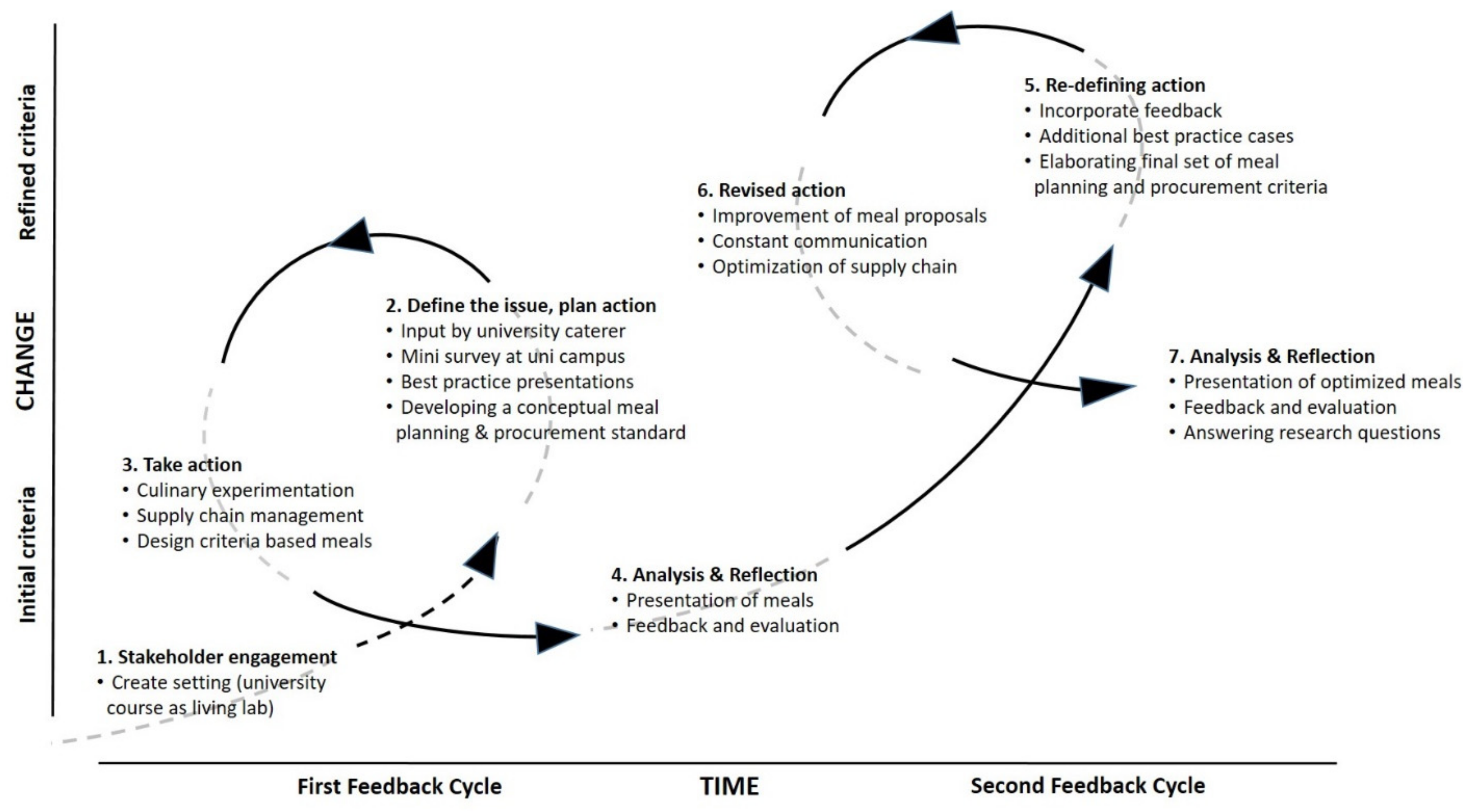

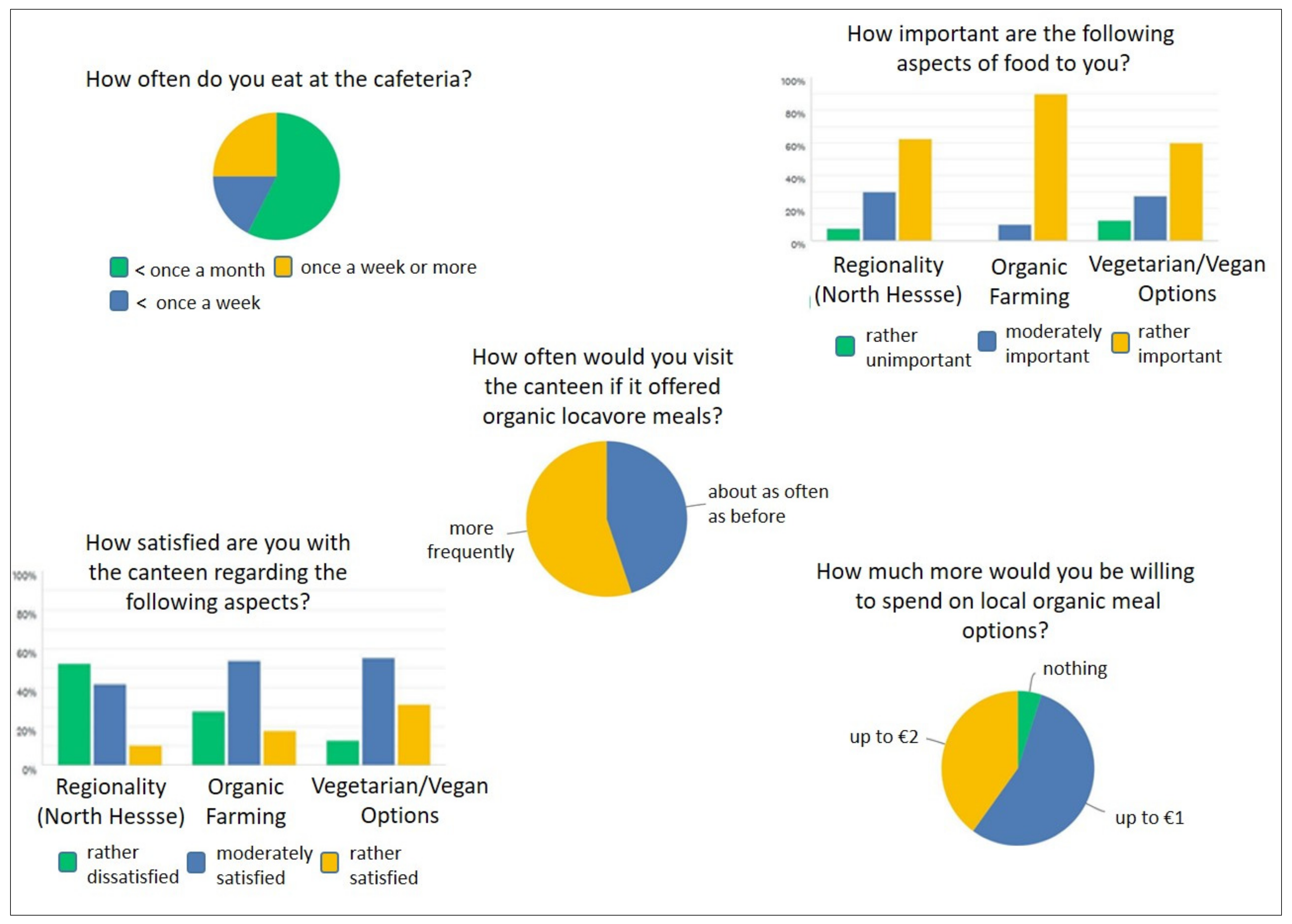
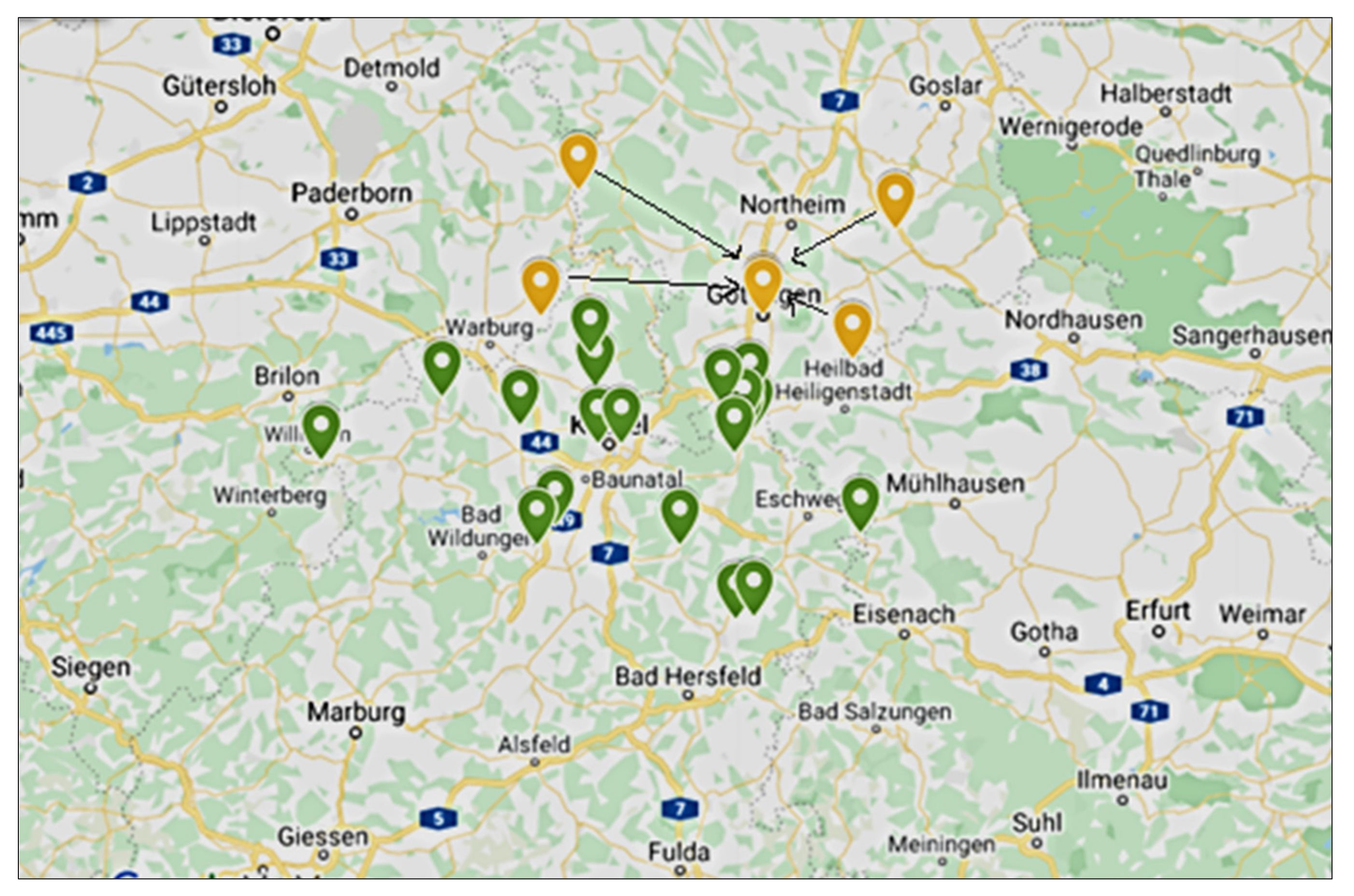
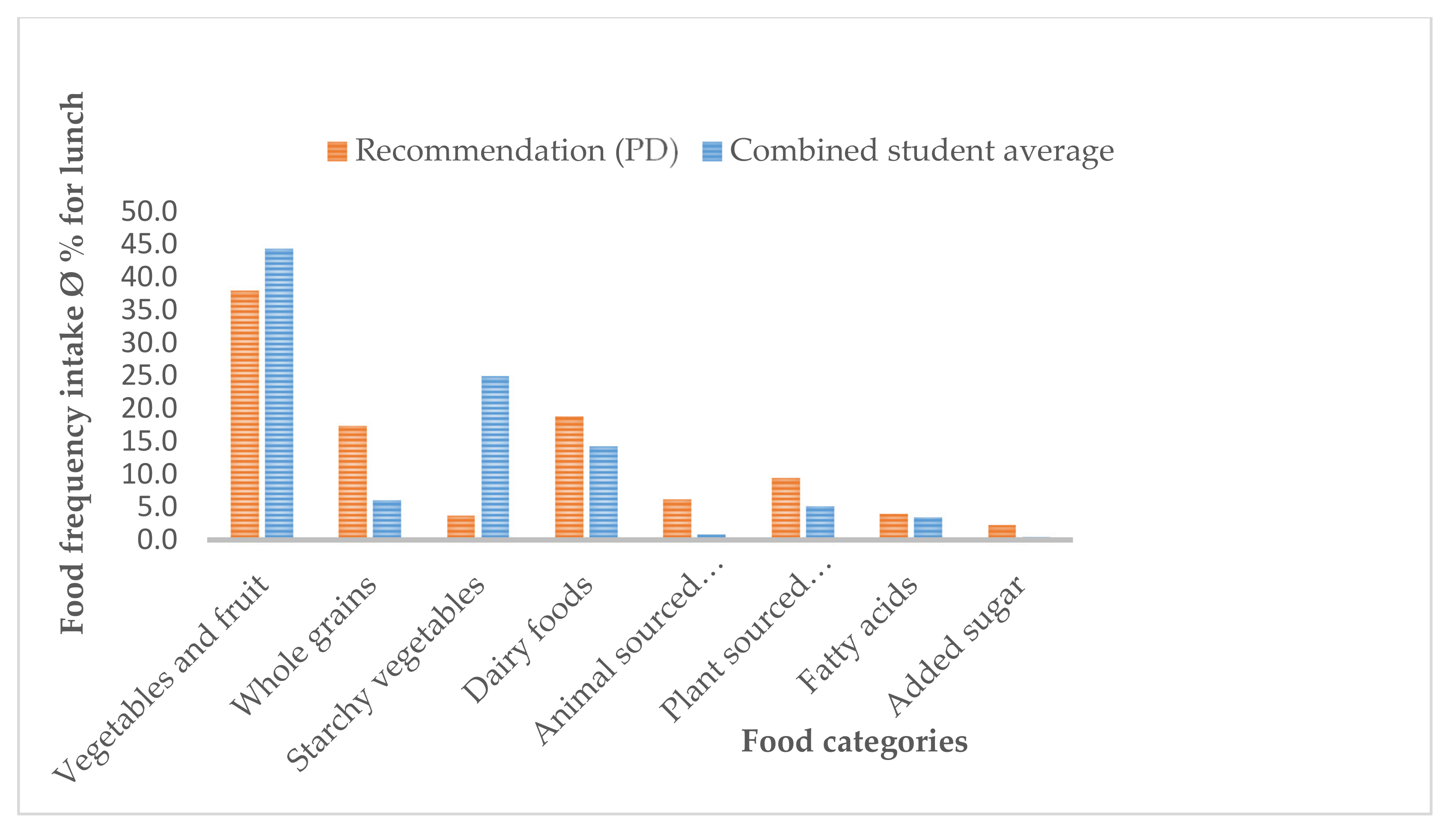
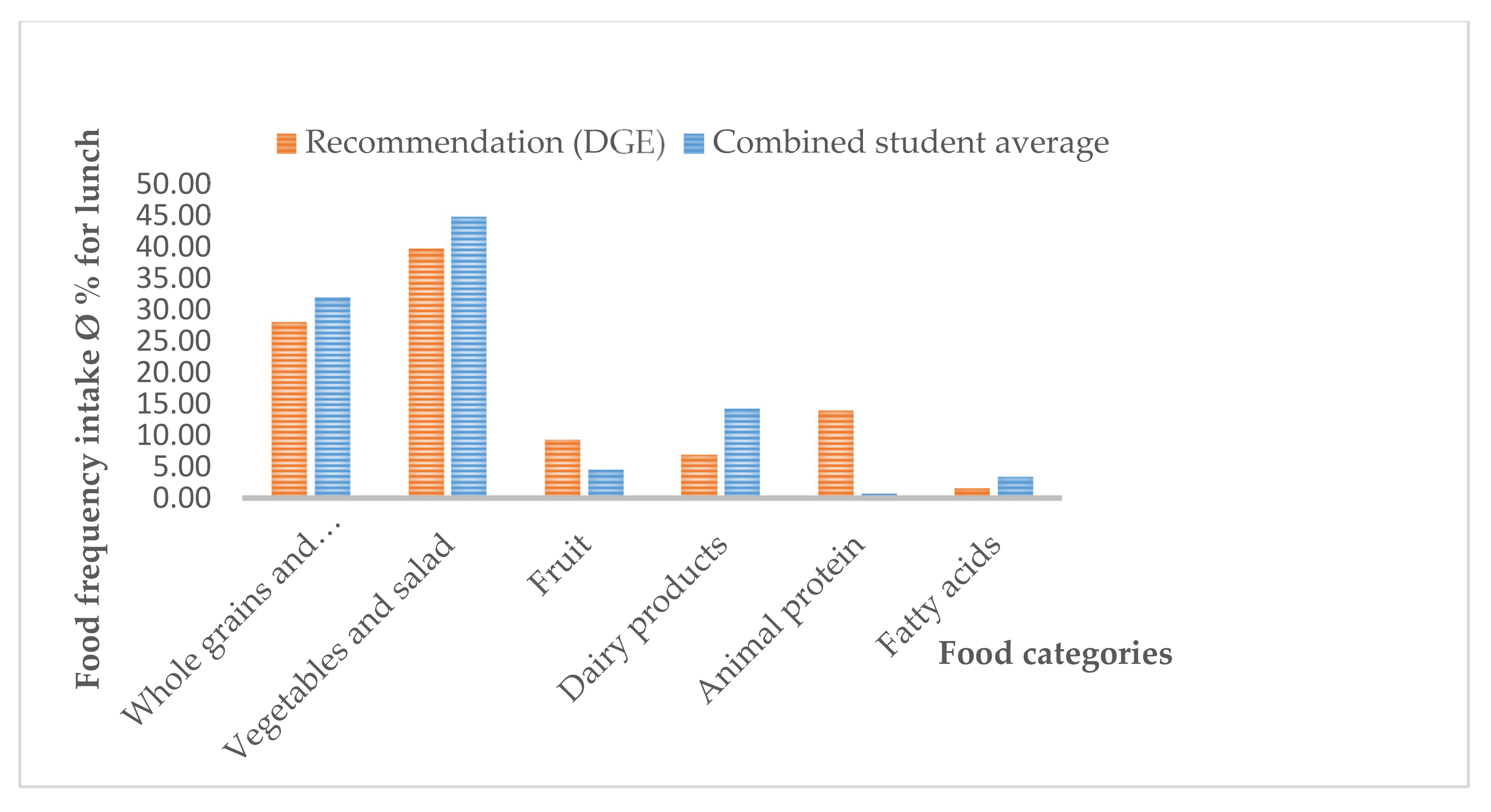
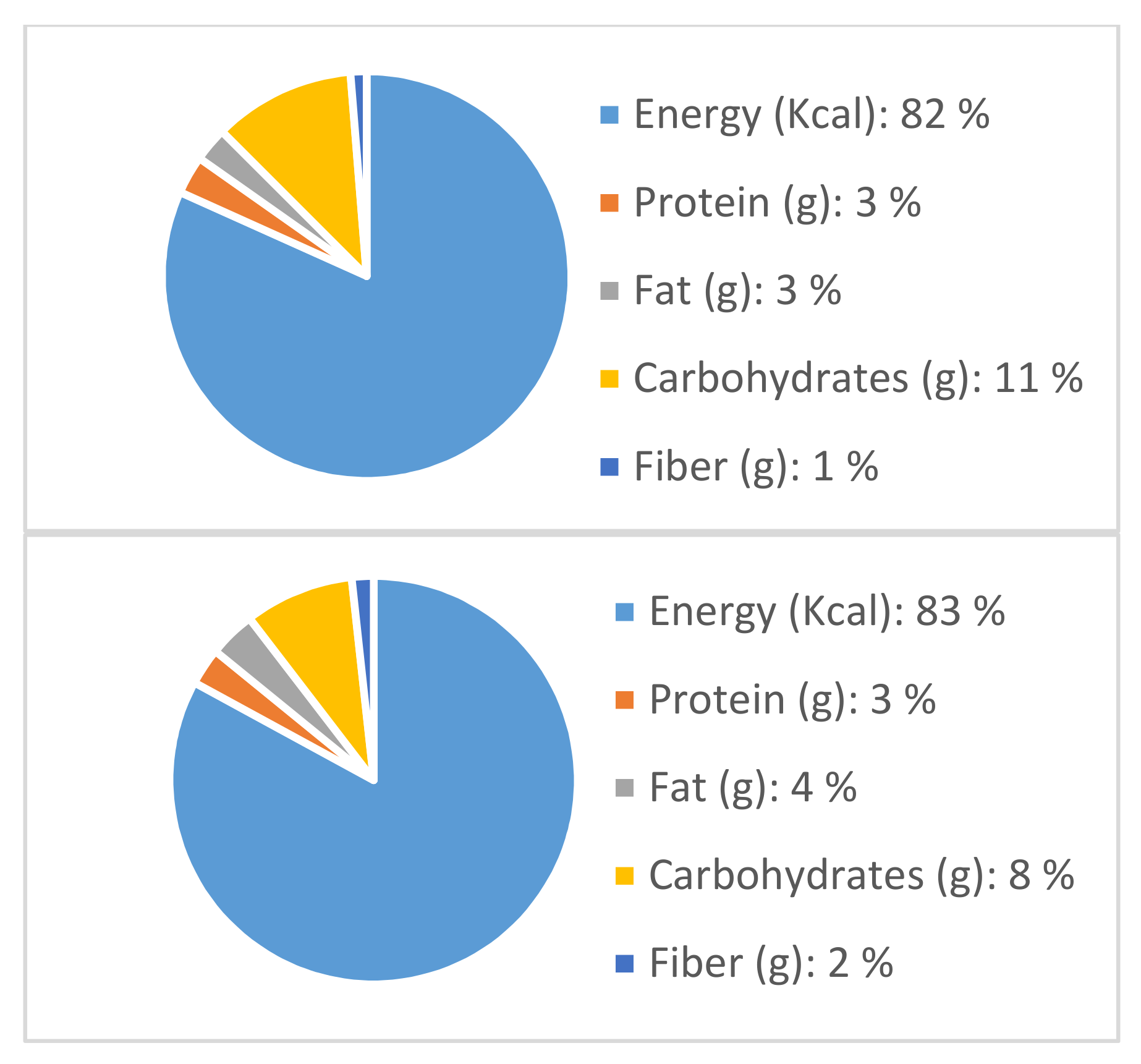
| Food Groups | Planetary Health Diet (Per Day) Macronutrient Intake Ø % Day | PD on a Lunch Basis (35% of Total) Macronutrient Intake Ø % for Lunch |
|---|---|---|
| Wholegrains (rice, wheat, corn, etc.) | 17.5 | 6.1 |
| Tubers/starchy veg. (i.e., potatoes, cassava) | 3.8 | 1.3 |
| All vegetables | 22.7 | 8 |
| All fruits | 15.1 | 5.3 |
| Dairy foods | 18.9 | 6.6 |
| Animal protein sources | 6.3 | 2.2 |
| Plant protein sources | 9.4 | 3.3 |
| Unsaturated oils | 3.0 | 1.05 |
| Saturated oils | 0.9 | 0.3 |
| Added sugars | 2.3 | 0.8 |
| Case | Standards |
|---|---|
| BIOND—organic catering service for schools and kindergarten, operating nationwide |
|
| The “Diet Unit” of the Municipality of Södertälje, Sweden |
|
| BioMensa U-Boot—100% organic cafeteria at the Dresden Technical University |
|
| Adelhaus—locavore organic vegetarian restaurant in Freiburg |
|
|
| Meal | Description |
|---|---|
| (1) Main dish: North-Hessian Ossobuco Side dish 1: Boiled potatoes Side dish 2: Savoy cabbage and apple salad | North-Hessian Ossobuco is a stew of braised seasonal vegetables, herbs, and a small portion of cross-cut veal shank that gives the stew a deep aromatic flavor. The side dishes include salted boiled potatoes and an apple savoy cabbage salad seasoned with salt, apple vinegar, and linseed oil. |
| (2) Main dish: Golden brown mozzarella patty Side dish 1: Potato wedges Side dish 2: Endive salad | A mozzarella patty coated in flour and breadcrumbs, fried on both sides until golden brown, and garnished with jam. A side dish of baked potatoes and endive salad seasoned with finely chopped onions, vinegar, oil, and salt. |
| (3) Main dish: Beetroot and green spelt patty with a herb quark dip Side dish 1: Lentil soup with smoked tofu Side dish 2: Red cabbage salad | Beetroot and green spelt patty with a herb quark. Lentil soup with regional lentils and smoked tofu and a red cabbage salad seasoned with oil, salt, sugar, and apple cider vinegar as side dishes. |
| (4) Main dish: Savoy cabbage roulade filled with lentils, vegetables, and oats Side dish 1: Pumpkin and oat “risotto” Side dish 2: Carrot mash | Oven-baked savoy cabbage roulades filled with lentils, naked oats, and vegetables with a side dish of pumpkin and oat “risotto” and a carrot mash. |
| (5) Main dish: Savoy cabbage stew Side dish 1: Lentil salad Side dish 2: Quark with apples and walnuts | A savoy cabbage stew with vegetables and potatoes and seasoned with salt. Side dishes include a lentil salad with vinegar and oil vinaigrette stretched with apple juice and an apple quark with honey, cinnamon, and walnuts. |
| Meal | Feedback |
|---|---|
| (1) Main dish: North-Hessian Ossobuco Side dish 1: Boiled potatoes Side dish 2: Savoy cabbage and apple salad |
|
| (2) Main dish: Golden brown mozzarella patty Side dish 1: Potato wedges Side dish 2: Endive salad |
|
| (3) Main dish: Beetroot and green spelt patty with a herb quark dip Side dish 1: Lentil soup with smoked tofu Side dish 2: Red cabbage salad |
|
| (4) Main dish: Savoy cabbage roulade filled with lentils, vegetables, and naked oats. Side dish 1: Pumpkin and naked oat “risotto” Side dish 2: Carrot mash |
|
| (5) Main dish: Savoy cabbage stew Side dish 1: Lentil salad Side dish 2: Quark with apples and walnuts |
|
| Case Study | Standards |
|---|---|
| Food for Life program (British Soil Association) works with public and private sectors in promoting healthy and sustainable school lunches |
|
|
| Meal | Description | Feedback by Kassel ASAS |
|---|---|---|
| (1) Main dish: North-Hessian Ossobuco Side dish 1: Boiled potatoes Side dish 2: Savoy cabbage and apple salad |
|
|
| (2) Main dish: Golden brown mozzarella patty Side dish 1: Potato wedges Side dish 2: Endive, carrot salad |
|
|
| (3) Main dish: Beetroot and naked oat patty with a herb dip Side dish 1: Potato wedges Side dish 2: Carrot salad |
|
|
| (4) Main dish: Savoy cabbage roulade filled with lentils, vegetables, and oats. Side dish 1: Pumpkin and oat “risotto” Side dish 2: Carrot mash |
|
|
| (5) Main dish: Savoy cabbage stew Side dish 1: Lentil salad Side dish 2: Yoghurt with apples and walnuts |
|
|
| - | Meal 1 | Meal 2 | Meal 3 | Meal 4 | Meal 5 |
|---|---|---|---|---|---|
| Cost of goods/portion (EUR) | 1.60 | 2.25 | 1.28 | 1.54 | 1.59 |
| Menus | North Hessian Ossobuco with Boiled Potatoes and Savoy Cabbage and Apple Salad | Golden-Brown Mozzarella Patty with Potato Wedges and An Endive Carrot Salad | Beetroot and Naked Oat Patty with a Herb Dip, Potato Wedges, and a Carrot Salad | Savoy Cabbage Roulade Filled with Lentils, Vegetables, and Naked Oats with a Pumpkin and Naked Oat “Risotto” and a Carrot Mash | Savoy Cabbage Stew with a Lentil Salad and Yogurt with Apples and Walnuts | |
|---|---|---|---|---|---|---|
| LCA Categories | ||||||
| Environment | ||||||
| Material expense | ||||||
| GHG emissions | ||||||
| Water requirement | ||||||
| Space requirements | ||||||
| Health | ||||||
| Energy content | ||||||
| Dietary fiber | ||||||
| Fat content | ||||||
| Carbohydrate | ||||||
| Added sugar | ||||||
| Salt content | ||||||
| Fair for human and animal | ||||||
| Animal welfare | ||||||
| Fairtrade | ||||||
Publisher’s Note: MDPI stays neutral with regard to jurisdictional claims in published maps and institutional affiliations. |
© 2021 by the authors. Licensee MDPI, Basel, Switzerland. This article is an open access article distributed under the terms and conditions of the Creative Commons Attribution (CC BY) license (https://creativecommons.org/licenses/by/4.0/).
Share and Cite
Kretschmer, S.; Dehm, S. Sustainability Transitions in University Food Service—A Living Lab Approach of Locavore Meal Planning and Procurement. Sustainability 2021, 13, 7305. https://doi.org/10.3390/su13137305
Kretschmer S, Dehm S. Sustainability Transitions in University Food Service—A Living Lab Approach of Locavore Meal Planning and Procurement. Sustainability. 2021; 13(13):7305. https://doi.org/10.3390/su13137305
Chicago/Turabian StyleKretschmer, Sebastian, and Sheena Dehm. 2021. "Sustainability Transitions in University Food Service—A Living Lab Approach of Locavore Meal Planning and Procurement" Sustainability 13, no. 13: 7305. https://doi.org/10.3390/su13137305
APA StyleKretschmer, S., & Dehm, S. (2021). Sustainability Transitions in University Food Service—A Living Lab Approach of Locavore Meal Planning and Procurement. Sustainability, 13(13), 7305. https://doi.org/10.3390/su13137305





